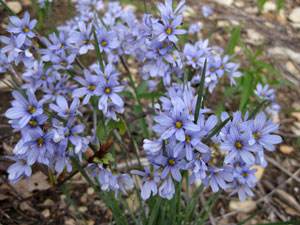Resource Library
Plant of the Week: Grass, Blue-Eyed
The University of Arkansas System Division of Agriculture does not promote, support or recommend plants featured in "Plant of the Week." Please consult your local Extension office for plants suitable for your region.
Plant of the Week
Blue-Eyed Grass
Latin: Sisyrinchium angustifolium

Wildflowers come in an array of sizes and shapes, but I have a particular fondness for the small ones with a special delicate charm. One of my favorites of mid-spring is blue-eyed grass, Sisyrinchium angustifolium.While this little plant is too small to appreciate at 70 mph blasting down the interstate, it is common and alluring for those who will slow down and seek it out.
There are about 80 species of Sisyrinchium described in the New World, with none found native in the rest of the world. The most common flower color for this genus is blue but species and variants with yellow, orange or white flowers are described. Species of this member of the iris family are native to every state - even Hawaii - and all the Canadian provinces.
Sisyrinchium angustifolium, the narrowleafed blue-eyed grass, is one of the most widely distributed species found throughout all the eastern states and in every county in Arkansas. It grows about 12 inches tall with narrow, flat grass-like, olive-green leaves arranged in a flat, iris-like fan. The below ground part of the plant is a very short, swollen rhizome. Leaves appear early in the spring and remain throughout the summer.
The blue flowers emerge from mid- to late-spring and arise from slits in the stem (a modified stem called a spathe) with from three to 11 flowers produced per stem over the blooming season. The flowers are about a half-inch across, six-tepaled with blue to violet flowers (or occasionally white) with a yellow center. Plants remain in bloom for about a month. Seeds are produced in a small brown capsule.
I boldly identified the blue-eyed grass growing in my garden as Sisyrinchium angustifolium, primarily because this species appears to be the most common in Arkansas. Botanists readily admit that distinguishing between the various species and identifying only one individual plant is very difficult. Blue-eyed grasses tend to do what botanists call “intergrade” - forming characteristics intermediate between two established species.
This inability to distinguish between established species tells us two things. First, botanists tend to split the species too finely. With a group such as blue-eyed grass, fewer species with well-defined and discernable characteristics would better serve the scientific community and the wildflower enthusiast.
The second thing it tells us is that this group of plants is a new and rapidly evolving genus. We are observing it soon after its biological Big Bang moment. Its absence from Europe and Asia identifies it as a young genus, emerging probably in the last 10 or so million years. The fact that separating the species is so difficult - and that all of these intergrades exist - indicates gene shuffling is in a high state of flux, and that solid, easily discernable species are still being established.
Not knowing for sure the identity of a clump of blue-eyed grass does not lessen the enjoyment of the plant in the garden. Blue-eyed grass is good for rock gardens, edging garden pathways or mixed with other low growing wildflowers in an informal border.
It is best in full sun but does well in my shade garden too. Plants will reseed occasionally, but are never weedy. To keep the clumps vigorous, divide every 3 to 5 years. ‘Lucerne,’ a selection of S. angustifolium found in Switzerland by plantsman Robert Herman when he was working for White Flower Farm nursery, is the only commonly offered cultivar of the group and is worth seeking out.
By: Gerald Klingaman, retired
Retired Extension Horticulturist - Ornamentals
Extension News - April 15, 2011
The University of Arkansas System Division of Agriculture does not maintain lists of retail outlets where these plants can be purchased. Please check your local nursery or other retail outlets to ask about the availability of these plants for your growing area.